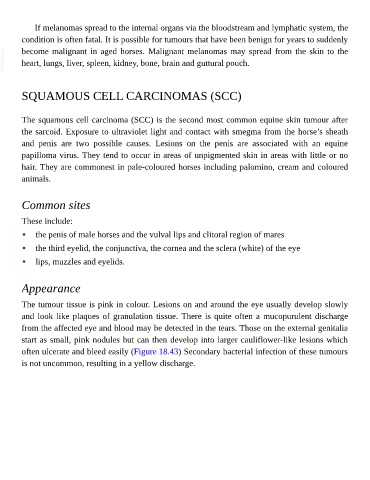Page 899 - The Veterinary Care of the Horse
P. 899
If melanomas spread to the internal organs via the bloodstream and lymphatic system, the
condition is often fatal. It is possible for tumours that have been benign for years to suddenly
VetBooks.ir become malignant in aged horses. Malignant melanomas may spread from the skin to the
heart, lungs, liver, spleen, kidney, bone, brain and guttural pouch.
SQUAMOUS CELL CARCINOMAS (SCC)
The squamous cell carcinoma (SCC) is the second most common equine skin tumour after
the sarcoid. Exposure to ultraviolet light and contact with smegma from the horse’s sheath
and penis are two possible causes. Lesions on the penis are associated with an equine
papilloma virus. They tend to occur in areas of unpigmented skin in areas with little or no
hair. They are commonest in pale-coloured horses including palomino, cream and coloured
animals.
Common sites
These include:
• the penis of male horses and the vulval lips and clitoral region of mares
• the third eyelid, the conjunctiva, the cornea and the sclera (white) of the eye
• lips, muzzles and eyelids.
Appearance
The tumour tissue is pink in colour. Lesions on and around the eye usually develop slowly
and look like plaques of granulation tissue. There is quite often a mucopurulent discharge
from the affected eye and blood may be detected in the tears. Those on the external genitalia
start as small, pink nodules but can then develop into larger cauliflower-like lesions which
often ulcerate and bleed easily (Figure 18.43) Secondary bacterial infection of these tumours
is not uncommon, resulting in a yellow discharge.

